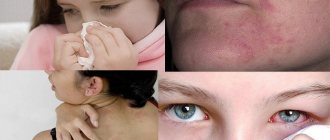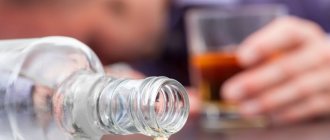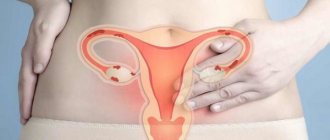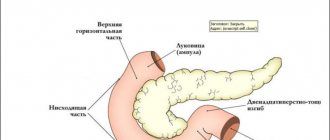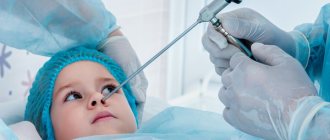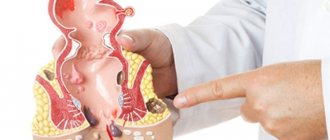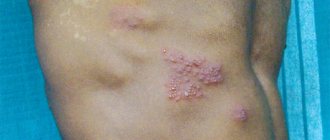Hepatomegaly of the liver - what is it?
This is a pathological increase in the size of the gland. Hepatomegaly
develops
against the background of diffuse
or focal
changes
in the liver, and is not considered as the underlying disease. This is a symptom indicating the presence of disturbances in the functioning of the body or the gland itself. But it certainly requires attention!
If you do not pay attention to hepatomegaly, you may then encounter pain in the right side (because the liver capsule is stretched and the nerve endings are irritated) and degeneration of the gland tissue (hepatosis, fibrosis). You can find such a diagnosis in the conclusion after an ultrasound examination, computed tomography
You can find such a diagnosis in the conclusion after an ultrasound examination or computed tomography.
Naturally, there is no cure for hepatomegaly, because in order to return the liver to normal size, the cause must be eliminated.
In this article you will find practical information about natural hepatoprotectors through detox and liver cell support. This will be useful for those whose organ enlargement is associated with nutritional errors, bile stagnation, and fatty hepatosis.
In case of a serious infectious disease or the presence of a tumor, a doctor is needed for recommendations.
Differences in the course of the disease in adults and children
In children, liver enlargement is caused by other reasons. For infants, this is jaundice, which doctors recommend not to treat, as it goes away quickly on its own. The appearance of the disease in infants is caused by injuries received during childbirth, diseases of the mother’s endocrine system during gestation.
Pediatricians do not see any danger in liver enlargement in preschool children. The increase in the size of the organ is associated with the growth of the child, and over time the liver returns to normal. To maintain the functioning of the gastrointestinal tract in a normal state, a course of treatment with folk remedies is periodically carried out. They are harmless and have no harmful effects on the body.
If the volume of the gland is increased in a 7-year-old child and the size does not change over time, the reason for this situation may be:
- violation of metabolic processes;
- the appearance of metastases;
- congenital pathologies;
- problems with the bile ducts.
The child feels nausea, vomiting, and his skin turns yellow. Rashes appear, he quickly loses weight. In such a situation, the pediatrician conducts an examination and gives a referral for tests. After collecting complete information about your health condition, treatment is prescribed if necessary. Usually limited to following a diet and a gentle diet. After a period determined by the doctor, a repeat examination is carried out. If the volume of the enlarged liver returns to normal, the diet is canceled.
Additionally, the pediatrician may prescribe folk remedies. This will support the functioning of the organ, normalize the production and outflow of bile.
Diet
The key nutritional goals for a person with an enlarged liver are to reduce the load on the diseased organ and restore its functions, especially the outflow of bile. Whatever diseases cause hepatomegaly, fasting is not allowed - this is no less dangerous for the liver than excessive food consumption. Any diet for liver enlargement in adults and children requires compliance with several basic rules:
Fractional nutrition - small portions, frequent meals: this way you will protect the organ from overload and stimulate the frequent release of bile. It is advisable to eat at least 5 times per day (snacks count), and some patients should maintain an interval between meals of no more than 2 hours: the exact figure depends on lifestyle
Reducing the amount of protein in the diet - this is especially important for people suffering from cirrhosis, as they are at high risk of developing hepatic coma due to increased levels of ammonia in the blood. Refusal of spicy and fatty foods are the main sources of stress for the hepatobiliary system, due to which the enlarged liver can continue to grow in size.
The most used nutritional option by gastroenterologists for patients with liver diseases is treatment table number 5 (according to Pevzner), but before starting treatment, you should consult with a specialist. Not all diagnoses can be treated with a universal menu. If we focus on table number 5, then when treating hepatomegaly the following products are prohibited:
- baked goods, puff pastry products;
- dairy and fermented milk group with a fat content percentage above 5%;
- sauces;
- fatty meat (pork, lamb);
- fatty fish (sturgeon, trout, salmon, etc.);
- egg yolks;
- strong meat/fish broths;
- fast food, semi-finished products, sausages;
- canned food;
- legumes;
- sorrel, spinach;
- cocoa and its derivatives;
- confectionery;
- refined sugar;
- coffee;
- carbonated drinks.
The basis of the diet during treatment for hepatomegaly is vegetables, preferably heat-treated, fruits, and herbs. Cereals, vegetable and milk soups, river fish, dietary meat (chicken, turkey, veal) are allowed. Milk derivatives are taken low-fat, in small quantities. Every day you are allowed to eat 1 whole egg, prepare compotes with dried fruits, but without sugar. Weak tea, freshly squeezed vegetable and fruit juices, non-acidic berries, honey, and marmalade are not prohibited. Rarely is butter or olive oil added to prepared dishes.
Sample menu for the week
The diet of a person with an enlarged liver should include boiled or baked pumpkin and beets, of which 150-200 g are eaten daily (maximum amount - 1 kg). Don’t give up cranberry juices/fruit drinks or rosehip decoction - they contain a large amount of vitamins and nutrients. While an enlarged liver is being treated, it is advisable for the patient to adhere to the following menu:
| Monday | Steamed cheesecakes, weak tea | Persimmon (2-3 pcs.) | Milk soup with noodles | Glass of pumpkin juice | Steamed chicken breast with orange |
| Oatmeal with banana | Dried fruit compote without sugar | Steamed turkey soufflé | Flourless cottage cheese casserole | Vegetable stew | |
| Cottage cheese (2-5%) with a spoon of 10% sour cream and herbs | Baked pumpkin (200 g), dried bran bread | Pilaf without meat | Vegetable salad with a spoon of olive oil | White fish soufflé, steamed green beans | |
| Buckwheat porridge with prunes | Currant jelly | Vegetable soup with brown rice | Applesauce with dried apricots | Steamed turkey fillet with vegetable salad dressed with lemon juice | |
| Rice porridge with raisins and honey | Baked pear with cottage cheese | Pasta with vegetable cutlets | Boiled egg, bell pepper | Steamed cod meatballs with carrots | |
| Oatmeal with a handful of almonds and an apple | Fresh pumpkin, zucchini and carrots | Boiled chicken breast without salt with vegetable salad | Baked apple with cinnamon | Vegetable casserole with sour cream and herbs | |
| Sunday | Egg white omelette with cucumber | Apple juice, grain bread | Vegetarian borscht | A glass of kefir or natural yogurt | Stewed veal with boiled beets |
Features of treatment of liver enlargement in children
When examining newborns, changes in the boundaries of the liver are often diagnosed. This symptom can be caused by birth injuries, infant jaundice, and pathological abnormalities in the mother (diabetes, endocrine disorders).
It is important to know! Medicines for liver enlargement in a child are used extremely rarely. It is believed that a slight change in an organ in preschool age is an acceptable condition. As we grow older, the borders of the liver acquire normal outlines. Only the doctor, after a complete examination, decides on the need for treatment.
Hepatomegaly in babies, accompanied by other warning signs, such as fever, vomiting, bulging veins in the abdomen, skin rash, aversion to food and rapid weight loss, yellowing of the mucous membranes and skin, requires additional examination by a gastroenterologist, infectious disease specialist and hepatologist. Tests and ultrasound will help clarify the diagnosis.
Causes of hepatomegaly in children
- hepatitis
- congenital infections
- toxic liver damage, often drug-induced
- obstruction (closing of the bile ducts)
- disruption of the outflow of bile and blood, etc.
A person’s well-being, and even life, largely depends on the condition of the liver. Bile, which the liver produces, helps digest dietary fats. The liver is involved in the synthesis of various substances, including vitamins, accumulates glycogen, which is a good source of energy for muscles, and it, being a filter in the body, converts toxic substances into safe ones.
But for various reasons, the basic functions of the liver are disrupted and then the body malfunctions, an imbalance occurs and the person gets sick. One sign of imbalance or dysfunction is an enlarged liver (). There are many reasons for this pathology, including acute hepatitis, heart failure, fatty hepatosis, and may also be due to hereditary diseases, for example, metabolic disorders.
How to determine liver enlargement in the clinic
It is quite dangerous to independently diagnose and treat at home, without the intervention of a doctor. This can lead to serious consequences that are dangerous to human health and life. The liver is one of the vital organs. It should only be treated under the guidance of a medical specialist.
For a correct diagnosis, the following activities are carried out:
- Clinical/biochemical blood test: determines the degree of damage to the diseased organ, the level of inflammatory and infectious disorders, liver enzymes.
- General urine analysis.
- Examination of feces.
- Analysis for viral hepatitis.
- Tissue biopsy (to detect fibrosis, cancer, hepatosis).
Reliable results are obtained from computed tomography and magnetic resonance imaging performed by an experienced specialist.
Ultrasound will help to understand why and how enlarged the liver is in children and adults. This is a completely safe, fairly accurate method. Ultrasound helps determine the enlargement of the organ, assess the condition of the portal vein and hepatic artery. Ultrasound is effective even in the early stages, as it visualizes that a person’s liver is enlarged by 1 cm or less.
In a normal, healthy state of the organ, the parameters should be as follows:
- length is 14-20 cm;
- in the sagittal plane its size is equal to 9-12 cm;
- the length of the right lobe is 11-15 cm, with a permissible error of 3 cm, in cross section 20-22 cm;
- the transverse thickness of the left lobe of the liver is approximately 6 cm, and the height is about 10 cm;
- normal flow state of the bile ducts.
Deviations from the norm are considered moderate if they differ by no more than 2 cm. If the right lobe of the liver is enlarged by 2 or more centimeters, consultation with a gastroenterologist or hepatologist is necessary.
How effective is the treatment of hepatomegaly with herbs?
Hepatomegaly is not a disease, but only its manifestation. In the vast majority of cases, the gland can return to normal size if the cause of the disease is adequately eliminated (basic therapy). Therefore, you need to understand that treatment of an enlarged liver with folk remedies is purely auxiliary in nature, which, at best, can weaken the clinical manifestations of hepatomegaly or have no effect. The main thing is not to self-medicate, as this can distort the effect of traditional methods, aggravate the patient’s condition and even lead to irreversible consequences. That is, you can’t use herbs, and you should remember this.
Chemical components contained in medicinal plants are quite often used in the production of pharmacological drugs (Gepabene, Karsil, Hepatofalk, Bonjigar). An easier way is to treat an enlarged liver directly with these herbs.
Enlarged liver - causes, treatment and diet
It is incorrect to call hepatomegaly a disease.
Rather, it is a symptom or a harbinger of a disease. The causes of liver enlargement are different, and the choice of treatment and diet depends on them. Why does hepatomegaly occur? It is very difficult to name one possible reason. Moreover, to determine why the liver is enlarged, each patient needs to undergo a comprehensive diagnosis with ultrasound, tests, and, if necessary, MRI and biopsy.
As practice shows, most often pharmaceuticals and folk remedies for the treatment of an enlarged liver have to be taken due to:
- hepatitis A;
- helminthic infestations;
- infections (both viral and bacterial origin);
- cholelithiasis;
- cyst;
- benign and malignant tumors;
- fatty hepatosis;
- cholestatic hepatosis;
- hemochromatosis;
- cirrhosis;
- alcohol abuse;
- excessive intake of dietary supplements, certain vitamins and medications;
- poisoning with industrial or plant toxic substances;
- leukemia;
- amyloidosis;
- cholangitis;
- mononucleosis;
- acute heart failure;
- blockage of the hepatic veins.
Treatment for enlarged liver
Therapy must be aimed at eliminating the underlying cause of hepatomegaly and be carried out under the supervision of specialists. Complex treatment is considered the most effective. It involves taking hepatoprotectors and other medications, using traditional recipes, following a diet, and adjusting lifestyle.
The most effective medications for treating an enlarged liver are the following:
- The main active ingredient in Ursofalk
is ursodeoxycholic acid. The drug is prescribed to those patients who have developed hepatomegaly due to hepatitis or toxic damage. Improvement in the patient's condition occurs due to the normalization of the biliary tract. - Galstena
is a universal drug that is suitable for all groups of patients. - Ovesol
is a herbal medicine for the treatment of enlarged liver. It cleanses the organ of toxins. - Essentiale
helps to effectively restore organ cells. In addition, the medicine affects the functioning of the cardiovascular system and reduces cholesterol in the blood. - Karsil
prevents inflammatory processes and improves metabolism.
Folk remedies for treating hepatomegaly
Regardless of the causes and symptoms, an enlarged liver can be treated with folk remedies:
- A decoction of corn silk is not very tasty, but it fights hepatomegaly faster than many medications.
- A popular remedy is oat jelly. It is prepared like a regular delicacy, only cereal grains are used as the basis.
- Pumpkin is not only tasty, but also very healthy. Fresh berries have the most benefits. The baked product contains less nutrients. And during frying, all vitamins and beneficial elements disappear.
- If you have hepatomegaly, you need to drink juice. Preferably freshly squeezed - from carrots, beets or apples with the addition of honey.
- Cranberries added in small quantities to tea will also help to shrink the liver.
Diet for an enlarged liver
Proper nutrition is one of the most important components of treatment. The liver is the body's natural filter. Everything a person eats or drinks passes through it. Accordingly, if you eat a lot of useless and dangerous food, the organ will have a very hard time.
For those who have been diagnosed with hepatomegaly, it is advisable to avoid:
Forms of development
Depending on the size of the enlarged organ, experts distinguish three forms of the syndrome.
Unexpressed - characterized by a slight increase. The syndrome can be painless, which makes its early diagnosis and diagnosis difficult. Without adequate treatment, it progresses or goes away on its own.
Moderate liver hepatomegaly
– changes in the structure and size of the gland are observed that do not correspond to the concept of normal. The syndrome is progressing. Doesn't go away on its own
Severe - a significant increase in the size of the liver is diagnosed, which begins to put pressure on neighboring organs and is subject to diffuse changes.
In the process of making a diagnosis, specialists study the anatomical and morphological characteristics of the increase.
In the doctor's report you can find the following expressions:
Partial syndrome - there is an uneven increase in the organ. For example, only the lower edge of the liver, the right or only the left lobe is enlarged. For example, for tumors
Diffuse hematomegaly - the entire organ is subject to structural changes and an increase of 10 cm or more. For example, with fatty hepatosis, cirrhosis
Hepatolienal syndrome – the liver and spleen are susceptible to enlargement at the same time. For example, for infections or blood diseases
Diagnostics
If the liver is enlarged, the doctor conducts a comprehensive examination to clarify the root cause of this symptom, establish a diagnosis and prescribe the correct treatment.
The diagnostic program may consist of the following activities:
- physical examination with palpation (if the liver is greatly enlarged, this will be clearly visible), clarification of complaints, medical history and life history;
- general and biochemical blood test;
- general analysis of urine and feces;
- determination of markers of viral hepatitis;
- biopsy of the affected organ;
- Ultrasound;
- radiography;
- immunological studies.
Liver biopsy
The diagnostic program can be adjusted depending on the current symptoms, the patient’s condition, medical history and the patient’s life.
Symptoms of an enlarged liver
An increase in liver size can be detected by yourself if symptoms such as:
- Feeling of discomfort and inconvenience in the right hypochondrium.
- Dyspeptic disorders - heartburn, belching, nausea, change in stool.
- Change in skin color - yellowness is possible.
- Nervousness, irritability, drowsiness.
But, the above symptoms may also refer to other disorders in the functioning of the whole organism, so for a reliable diagnosis it is better to visit a specialist. Don’t delay your appointment with your doctor – timely treatment will help avoid serious consequences.
Causes of liver enlargement
— Fatty hepatosis (exceeding the number of fat cells in the liver).
— Hepatitis of different types.
— Viral infections.
- Cirrhosis of the liver.
— Hereditary diseases based on impaired metabolism.
- Heart failure.
— The appearance of neoplasms: cysts, tumors.
— The influence of toxins.
- Cholelithiasis.
Diet for an enlarged liver
A harmoniously planned diet helps the liver overcome hepatomegaly. Dietary regimen for liver disorders excludes spicy, fatty and salty foods
The presence of proteins, vitamins and fiber is important in a balanced diet
The intake of food into the body should occur in small portions so that there is no overload of the diseased liver. It is advisable to eat small meals (up to six to seven times a day) for optimal digestion.
What is a healthy liver like?
The liver is a gland, that is, an organ consisting of cells that regularly produce specific substances into the body. This process affects the functioning of the entire endocrine system. The production of hormones, whose excess or deficiency can lead to serious problems in the body, depends on it.
And this is only an indirect influence of the largest gland in the human body.
Appearance
All vertebrates have a liver, so its appearance has never been a secret to humans. In a healthy person, it is red-brown, has a uniform structure and weighs, on average, one and a half kilograms.
Under the influence of unfavorable factors, the organ changes in size, becomes gray and loose.
Structure
Scientists have been studying the structure of the liver for a long time. The gland itself consists of right and left lobes. In 1957, French surgeon Claude Quiono first described a graphical representation, dividing the liver into 8 segments.
This scheme is still relevant and is used by surgeons today.
Location
The gland is located in the human abdominal cavity. Most of it (about 75%) is located on the right, but due to its impressive size it reaches the left hypochondrium.
Operation
The liver distills up to 2 liters of blood per day, filtering it several hundred times.
How to understand that the liver is enlarged
The patient recognizes the problem mainly by unpleasant symptoms, which can also be observed when the organ is not too enlarged (when independent palpation brings almost no results). Hepatomegaly is always characterized by a feeling of discomfort in the right hypochondrium, among the unpleasant moments is a feeling of heaviness and pressure. Additionally there may be:
- yellowing of the skin and mucous membranes;
- changes in the color of urine and feces;
- heartburn;
- severe belching, nausea;
- increased irritability, emotional instability.
More accurate ways to detect an enlarged liver are classical methods of examining the hepatobiliary system - MRI, CT, ultrasound. With hepatomegaly along the right clavicular line, the organ is more than 12 cm in length and can be easily palpated in the left lobe of the epigastric zone. You should definitely keep track of the following points:
- presence or absence of organ prolapse;
- the presence of third-party tissues in the right hepatic quadrant;
- sensations during palpation - density of the palpated area, pain.
Establishing diagnosis
Since liver enlargement is not recognized as a disease itself, the doctor determines the cause that caused the body’s specific reaction and chooses a treatment method. To do this, the patient is examined in several ways:
- examination of the external skin and palpation of the right side of the abdominal cavity;
- CT;
- Ultrasound;
- MRI.
The patient undergoes blood, urine and stool tests. If necessary, undergo examination by various specialists.
To establish an accurate diagnosis, a general blood test is not enough. The presence of pathology is revealed by screening and spot studies. In order to detect deviations in the activity of the gland in time, you should donate blood for a biochemical analysis at least once a year. Particular attention should be paid to ALT and AST indicators.
For an accurate diagnosis, the following is detected:
- is there prolapse of the enlarged liver;
- how much larger the liver is than normal;
- whether there is pain when pressing on the peritoneum;
- whether the presence of third-party tissues is present in the right quadrant.
After studying the data obtained, the cause that caused the liver enlargement is determined and a course of therapy is selected. First of all, the main cause of the increase in size is eliminated and restorative treatment for the liver is carried out.
In a normal state, the liver cannot be felt during palpation. If the volume increases by 3-4 cm, no measures are taken to restore the normal state. If the size of the gland exceeds the norm by up to 9 cm, it is necessary to take measures to eliminate the problem.
How and what to treat correctly
The course of treatment for liver enlargement should be prescribed by a doctor. Additional diseases and the degree of development of pathology play an important role. If there are serious complications and disruption of important systems, surgical intervention may be necessary.
The duration of treatment directly depends on the timeliness of diagnosis and the underlying disease that provoked hepatomegaly. On average, this process takes several months. If there are complications, the prognosis is alarming. The liver may lose its ability to perform some functions.
Medicines
Drugs for the treatment of liver enlargement are prescribed individually
During therapy, it is important to eliminate or stop the development of the disease that caused hepatomegaly. Self-medication in this case is unacceptable
Taking the wrong medications will not only not get rid of the problem, but will also worsen the general condition of the body.
- drugs with anti-inflammatory effect (Allohol, Essentiale);
- medications with restorative properties (Gepamerz, Hepatrin);
- preparations with milk thistle extract (Legalon);
- hepatoprotectors (Essliver Forte);
- homeopathic medicines (Galstena);
- herbal preparations (Ovesol, Gepabene);
- vitamins B and E in capsules.
Folk remedies
Alternative medicine recipes are recommended to be used as an auxiliary method in the treatment of liver enlargement. It is better to discuss folk remedies with your doctor. Natural components can improve the functioning of internal organs and improve the general condition of the body, but they cannot replace medical procedures or medications.
Examples of folk remedies:
Medicinal herbs
Medicinal herbs help speed up the treatment process and normalize liver function. Some of them improve the flow of bile and remove harmful toxins from the body. Herbs can be added to salads or used to make infusions. For a glass of boiling water you will need one teaspoon of dry mixture. Herbs can be combined with each other in one decoction.
- young lady;
- roots;
Medical nutrition
If the liver is enlarged, it is imperative to exclude foods that can aggravate the condition from the patient’s diet. These include legumes, radishes, spinach, radishes, sorrel, peppers and mustard. It is not recommended to eat sausages, baked goods, white bread, spicy and fatty foods. Confectionery products, chocolate, alcoholic and carbonated drinks are also excluded from the diet. You should not eat lamb, goose and liver.
The menu must include the following food products:
- soups with added cereals;
- lean meat;
- dairy and fermented milk products;
- cauliflower;
- pumpkin;
- zucchini;
- carrot;
- grape;
- apples;
- lemon;
The main feature of the diet for liver enlargement is compliance with the rules of fractional and balanced nutrition. The body must receive a sufficient amount of vitamins, proteins, fats and carbohydrates. It is recommended to completely exclude harmful components. The menu should not contain pickled, smoked, salted or fried foods. Such categories of products negatively affect not only the liver, but also the digestive system as a whole. Dishes should be prepared by boiling or steaming.
Sample menu for the day:
- breakfast – rice porridge with milk, tea with honey;
- second breakfast – apple juice, oatmeal cookies;
- lunch - vegetable soup, steamed meatballs, rosehip broth;
- afternoon snack - dried fruits poured with boiling water;
- dinner – boiled fish with boiled carrots;
- before bed – a glass of kefir.
Some diseases that are accompanied by liver enlargement can only be treated with special medical procedures.
You cannot ignore their symptoms or self-medicate. In addition, by following the rules of a healthy diet and an active lifestyle, you can prevent the development of many pathologies. The liver plays an important role in the body. If there are malfunctions in the functioning of this organ, the functioning of other systems is disrupted. If the liver is enlarged, you cannot ignore the symptoms and neglect the treatment of the pathology
It is important to undergo a full examination as soon as possible and identify the cause of the development of hepatomegaly. It is not worthwhile to carry out therapy only with medicinal herbs or folk recipes
Such treatment may alleviate symptoms, but will not get rid of the underlying disease.
- self-medicate;
- prematurely interrupt the course of treatment;
- independently select medications for treatment;
- neglect the rules of dietary nutrition;
- eat prohibited foods;
- abuse alcohol;
- ignore signs of exacerbation of the disease.
What role does the liver play?
The liver is an irreplaceable organ in the human body that performs a number of important functions:
- Gluconeogenesis. Gluconeogenesis is the process by which non-carbohydrate compounds are converted into glucose. This allows you to maintain a sufficient amount of carbohydrates in the blood - the most important sources of energy.
- Regulation of lipid metabolism. Lipids are substances consisting of alcohol and fatty acids. One of the functions of the liver is their breakdown, digestion and absorption.
- Hormone synthesis.
- Participation in metabolism. The liver removes excess hormones and vitamins from the body, as well as toxic metabolic products: ammonia, ethanol, phenol, acetone. Organ cells play a primary role in the process of intermediate metabolism.
- Neutralization. Xenobiotics are a category of substances foreign to the body that enter our body with food or from the air. They directly affect the skin, lungs and digestive organs. These include pesticides, some detergents, artificial dyes, etc. The work of the liver helps to neutralize xenobiotics. This prevents many problems: slowing metabolism, stopping organ growth, allergic reactions and malfunctioning of the immune system.
- Accumulation of energy reserves. Having a supply of energy reserves is essential. Especially for people who do not consume enough carbohydrates or practice fasting.
- Maintaining a constant blood composition.
- Participation in the process of hematopoiesis in the fetus.
Therapeutic diet for liver hepatomegaly
- to refuse from bad habits
- eat in small portions, dividing meals at least 6 times
- exclude fried foods, it is better to steam or boil everything
- exclude fatty foods, fat in the diet should be no more than 70 grams per day, fat should be of vegetable origin
- exclude baked goods, sweets and salty foods, canned food
— introduce more fresh or boiled, stewed vegetables, porridge, lean fish and poultry into your diet
Remember that without following a diet, no treatment will help you. The diet will help cope with the disease and will have a beneficial effect on the liver and the entire body as a whole.
Ways to eliminate hepatomegaly
Without timely treatment, the disease develops into liver failure; the pathology is many times more dangerous than a simple enlargement of the filtering organ. Treatment is aimed at eliminating the negative factors that caused the pathology.
How to cure an enlarged liver? The first step in eliminating the disease is taking hepatoprotectors. Such medications effectively protect hepatocytes from the harmful effects of alcoholic beverages and the toxic influence of the environment. Excellent results can be achieved with a course of taking the following:
Hepatoprotectors
Legalon
Hepatoprotector Legalon is a dark yellow capsule containing milk thistle seed extract.
Each capsule contains 140 g of active substance. Capsules must not be opened, as the natural substance begins to deteriorate when exposed to sunlight. Taking a hepatoprotector in this case is pointless.
Patients over 12 years of age and adults with hepatomegaly are prescribed one capsule three times a day.
The duration of the course is determined individually depending on the diagnosis and severity of the pathological process.
Rezalut Pro
The medication contains polyunsaturated phospholipids obtained from soy lecithin. The dosage regimen is adjusted by the doctor; the standard instructions recommend taking 2 tablets three times a day before meals.
Essentiale forte
Essentiale forte is a unique preparation containing essential phospholipids. The hepatoprotector is produced in the form of:
For the symptoms of hepatomegaly, 2 capsules are prescribed 3 times a day. To obtain a therapeutic effect, capsules are taken with meals, the duration of therapy is at least three months.
Galstena
Homeopathic hepatoprotector Galstena has a powerful anti-inflammatory, choleretic effect and is used as an antispasmodic.
1 ml of medicinal solution contains 25 drops of the active substance.
Children over 12 years of age and adult patients need to drink 10 drops per day, the product is taken in its pure form, or can be pre-diluted with a small amount of clean water.
The pathology can be cured provided that the person adheres to a diet during therapy.
Gepabene
The capsules are covered with a gelatin shell and inside contain dark or light brown granules with patchy white patches. The powder is made from dried leaves:
Women, men and children with hepatomegaly of varying severity are prescribed one capsule three times a day.
Liv-52
The combined natural hepatoprotector consists of chicory, cassia extract, nightshade, smokeweed, yarrow, and iron oxide. Adolescents over 14 years of age and adults are recommended to take 2 tablets three times a day.
Ovesol
Another effective drug for eliminating pain and other manifestations of pathological enlargement of the liver is Ovesol. The product is produced in tablets, in the form of an alcohol solution.
Liquid Ovesol is taken 15-20 drops twice a day. Tablets are indicated for taking 1 piece once. The course consists of 31 days of therapy.
Ancillary drugs
Mezim and Allochol are used as auxiliary means to eliminate the symptoms of hepatomegaly. They help improve the digestive process, replenish the lack of enzymes, provide improvement, and relieve symptoms of liver pathologies.
Therapeutic diet
Medicines will not help cure or restore the normal size of the liver if the patient does not adhere to proper nutrition. Smoked, fried, fatty foods, sweets, and baked goods are removed from the diet. Beans, sharp cheeses, and semi-finished products can aggravate the condition.
You can eliminate additional stress by eating small and frequent meals, eating 6-7 times a day. An important condition is regular monitoring of the amount of fat consumed. You need to include a sufficient amount of fiber, vitamins, and minerals in your diet.
Diet features
It is very important to follow a certain diet if you have liver diseases. It is aimed at maximizing the preservation and unloading of the organ, as well as preventing stagnation of the biliary tract
The basis is taken from the principles of nutrition, which include table 5. This is the so-called “liver” table, but it is also used for disorders of the pancreas, as well as for the purpose of losing weight.
If there is a disruption in the functioning of hepatocytes, the following should not be used as food:
- fresh bread and pastries;
- milk, cream, sour cream and other high-fat products;
- offal, fatty meat and fish;
- garlic, onion, radish;
- hot seasonings and spices;
- legumes, mushrooms, sorrel;
- tomatoes;
- sour fruits;
- cocoa, chocolate;
- strong coffee and tea;
- carbonated mineral water and other drinks with gas and dyes;
- alcohol.
For the patient, the diet involves eating:
- yesterday's bread and crackers;
- crackers;
- dietary meat;
- lean fish;
- oils (vegetable and butter);
- almost all vegetables;
- pasta and cereals;
- mild herb seasonings;
- jam, marmalade and honey.
Particular attention should be paid to proper preparation and consumption of food. You need to eat small portions 5-6 times a day
I boil or steam food. Occasionally you can bake dishes in the oven.
A more strict diet is required at first until all symptoms subside and treatment is completed. Then the menu is expanded, but at the same time the liver function is constantly monitored.
In complex therapy, you can use traditional methods to treat hepatomegaly. But they can only act as auxiliary means, and do not cancel the main prescriptions of the attending physician.
The appearance of a feeling of heaviness and pressure in the right hypochondrium, discomfort after eating, pain are the most striking symptoms of problems with the hepatobiliary system, which, if ignored, can lead to an increase in the size of the liver. When the organ becomes visible to the naked eye, the situation may turn out to be critical, so its swelling must be tracked and stopped at the initial stage. How to do this and what does an enlarged liver mean?
What factors negatively affect the liver?
Thanks to research, it has become possible to identify some foods that destroy the largest gland.
These include:
- Alcohol. Alcoholic drinks often lead to cirrhosis of the liver, a chronic progressive disease. If you begin to feel discomfort in the stomach, notice an increase in its volume, begin to get tired faster, and your gums are bleeding - this may indicate serious liver problems and be the initial stage of cirrhosis.
- Coffee. Caffeine has a diuretic effect and often leads to dehydration. If you drink coffee frequently, you should drink plenty of water because dehydration negatively affects your liver.
- Confectionery. Baked goods often contain margarine, sugar and dyes, and in addition they are products that contain fast carbohydrates. Abuse of such food leads to metabolic disorders.
- Spicy food. Products oversaturated with spices irritate internal organs. They cause inflammation, and in severe cases even burns. Such nutrition provokes the release of bile. Characteristic symptoms are pain and upset stomach.
- Fatty foods. These include fast food, lard, and meat. They are difficult to break down, digest and, accordingly, are excreted from the body.
- Long-lasting or stale food.
- Smoked products. They are dangerous because they contain phenol, which takes a long time to digest by the gland, causing damage to it.
In addition to food, the functioning of the liver is negatively affected by:
- binge eating;
- unbalanced diet;
- stress;
- frequent illness and use of medications;
- parasites;
- smoking;
- contaminated air.
Sample menu for liver enlargement for a week
Monday.
1st meal – Milk rice porridge without adding butter and sugar, green tea with honey or rosehip decoction.
Meal 2 – A glass of freshly squeezed apple juice, oatmeal cookies
Meal 3 – Boiled river fish
Meal 4 – Boiled carrots, grated
Meal 5 – Steamed vegetable dish (without salt and spices)
Meal 6 – Fresh fruit
Tuesday
1st meal – Omelet from one egg (without yolk), rosehip decoction or green tea, dietary biscuits
Meal 2 – Dried fruits (dried apricots, prunes, raisins), previously poured with boiling water.
Meal 3 – Veal or chicken broth, bran bread
Meal 4 – Freshly squeezed carrot juice, oatmeal cookies
Meal 5 – Low-fat cottage cheese
Meal 6 – Greens and cucumber salad
Wednesday
1st meal – Low-fat kefir or cottage cheese
Meal 2 – Rosehip decoction with honey, oatmeal cookies
Method 3 – Steamed meatballs
Meal 4 – Pumpkin puree, herbal tea
Meal 5 – Baked cheesecakes with dried fruits
Meal 6 – Freshly squeezed fruit juice, oatmeal cookies
Thursday
1st meal – Oatmeal with milk, green tea with honey and lemon
Meal 2 – Compote with dried fruits, dietary biscuits
Meal 3 – Steamed river fish, bran bread
Meal 4 – Fresh fruit juice, oatmeal cookies
Meal 5 – Vegetable casserole, bran bread
Meal 6 – Herbal tea
Friday
Meal 1 – Boiled pasta in small quantities
Meal 2 – A glass of freshly squeezed apple juice, biscuits
Meal 3 – Dietary buckwheat soup, bran bread
Meal 4 – Dried fruits soaked in boiling water
Meal 5 – Milk porridge, dietary biscuits
Meal 6 – Green tea with honey, oatmeal cookies
Saturday
1st meal – Buckwheat porridge cooked in water without salt and sugar, herbal tea
Meal 2 – Fruit platter
Meal 3 – Veal or chicken broth, bran bread
Meal 4 – Sauerkraut salad
Meal 5 – Pastila or fruit marmalade
Sunday
1st meal – Cheesecakes with dried fruits, cooked in the oven, green tea with honey and lemon
Meal 2 – Fruit or vegetable juice, biscuits
Meal 3 – Veal or turkey, boiled and pureed with the addition of boiled carrots or pumpkin
Meal 4 – Rosehip decoction, bran bread
Meal 5 – Kefir or cottage cheese, oatmeal cookies
Meal 6 – Fruit or vegetable salad
It is also necessary to maintain equal periods of time between meals. Any diet must be discussed with a doctor, who will give all the necessary recommendations. With an enlarged liver, nutrition should be optimally balanced. Therefore, it is periodically necessary to adjust and diversify the diet. If the liver is severely enlarged, it is advisable to dilute fruit and vegetable juices with boiled water in a 1:1 ratio. Alcohol, coffee, chocolate, confectionery, salt, pepper, vinegar are the main enemies of the liver. For any liver disease, legumes in any form, nuts, and carbonated drinks are contraindicated.
Symptoms of hepatomegaly
You should sound the alarm and consult a doctor as soon as possible if you suspect liver enlargement (hepatomegaly) if you experience the following symptoms:
- Heaviness and discomfort in the right side, under the ribs;
- Emotional instability, tearfulness, aggression;
- Frequent heartburn with nausea, belching;
- Change in color of stool and urine;
- Jaundice.
I would like to draw your attention again to the need to visit a doctor as soon as possible. This condition cannot go away without consequences, therefore, in order not to put yourself and your loved ones at risk, it is not recommended to delay a visit to the doctor.
As far as Prokishechni.ru knows, a slight enlargement of the liver in humans does not cause any discomfort. If the volume of the organ is at least 2 cm larger than required, then there are no suspicious signs and symptoms. But more serious changes in size are accompanied by a number of manifestations:
- Discomfortable sensations in the right hypochondrium;
- Problems with the gastrointestinal tract - heartburn, nausea, unpleasant belching, changes in stool;
- Yellowing of the skin and mucous membranes;
- Psychological disorders - sleep problems, nervousness, irritability.
For a number of diseases, the above symptoms may be supplemented by other signs of disease characteristic of a particular ailment.
Where does it hurt?
In most cases, a person may not feel an enlarged liver. Sometimes discomfort appears in the right hypochondrium and abdominal area. It can be stabbing, aching, throbbing pain in the right side.
What's troubling?
In addition to unpleasant sensations in the abdominal cavity, according to the intestines, increased fatigue and nervousness may be observed. The patient loses his appetite. The person begins to lose weight. Nausea is constantly felt and vomiting is observed.
Dermatological problems may occur: yellowing of the skin, itching, rash. Subcutaneous hemorrhages may also be observed. With hepatitis, the patient has an elevated body temperature.
The first symptoms of an enlarged liver are noted almost immediately: this is a bursting feeling in the right side, as if something is interfering, and when you change the position of the body, a dense lump is noted in the abdominal cavity. Almost always, the disease is accompanied by bad breath, attacks of nausea, heartburn, and stool problems.
The causes of hepatomegaly are explained not only by inflammatory diseases, but also by the presence of bad habits in the patient (smoking, alcohol, poor diet), hereditary factors, and working conditions.
Moderate hepatomegaly is rarely accompanied by any symptoms, since the parenchymal tissue of the liver does not have nerve endings. Specific signs appear when the organ is significantly enlarged. It can put pressure on nearby nerves or internal organs. Possible physical manifestations include:
- feeling of pressure in the right side;
- pain during physical activity;
- icteric syndrome;
- skin rash and itching;
- periodic discomfort in the epigastric and hypochondrium areas;
- dyspeptic disorders.
More often, such symptoms accompany serious or irreversible changes in the liver. Along with organ enlargement, the following may be present:
- uniform or nodular compactions, jaundice, symptoms of intoxication, pain in the right hypochondrium, their intensification upon palpation, which indicates hepatitis, cirrhosis;
- pain, jaundice, accompanied by ascites and dyspepsia, may indicate malignant liver lesions;
- moderate pain in an enlarged organ with severe pain in another part of the body may indicate the formation of metastases in the liver;
- tachycardia, shock, signs of internal bleeding appear with liver injuries.
In some cases, hepatomegaly is the main and only sign of pathology. It is observed in cases of degenerative organ lesions, blood supply disorders, and benign formations in the liver.
The weight of a healthy liver does not exceed one and a half kilograms. During various pathological processes, the weight of the organ can increase several times, as bile fills the cellular spaces. If left untreated, connective tissue grows in the cavity and scars form. Clinically, hepatomegaly manifests itself in advanced forms of pathology, when the organ protrudes from the right hypochondrium. In the initial stages, the disease manifests itself in the form of the following symptoms:
impaired digestion of food, which manifests itself in the form of nausea and vomiting;- discomfort in the right hypochondrium;
- bitter taste in the mouth;
- violation of the act of defecation;
- loss of appetite;
- apathy;
- slight increase in body temperature;
- change in color of the skin and sclera of the eyes to a jaundiced tint.
If the basis of the pathology is heart failure, then the patient is tormented by essential hypertension, hyperhidrosis and tachycardia.
With parasitic processes and malaria, hypotension is observed, the waist increases in girth, and the concentration of creatine kinase, liver enzymes, choline and bilirubin in the blood increases. Together with the liver, the spleen increases in size. The condition is called hepatosplenomegaly.
The clinical picture of liver pathologies develops gradually, poisoning the body with decay products and toxins. Palpation of the organ allows you to determine the source of pathology and the severity of the disease.
The edges of the liver protruding beyond the ribs indicate the onset of the pathological process. A protrusion of the organ visible to the naked eye indicates a more severe disease. If similar symptoms occur, you should immediately consult a doctor. Treatment is carried out by hepatologists, infectious disease specialists and gastroenterologists (depending on the cause of the disease).
At first, hepatomegaly is asymptomatic, making diagnosis difficult. When the organ enlarges by 1-2 cm, there are no signs. The only thing that may bother me is discomfort on the right side under the ribs - as if a foreign object is interfering there. Later appear:
- pain in the right hypochondrium;
- swelling of the face and limbs;
- bitter taste in the mouth;
- rapid fatigue, even if physical activity is minimal;
- insomnia or drowsiness;
- attacks of weakness and dizziness;
- nervousness, tearfulness;
- Gastrointestinal disorders - lack of appetite, bloating, nausea with vomiting, heartburn, belching, constipation or diarrhea;
- sometimes – bad breath;
- sudden weight loss;
- yellowing and itching of the skin and mucous membranes (due to compression of the bile ducts).
The following symptoms require emergency medical attention:
- confusion;
- very tired;
- hallucinations;
- fainting;
- high temperature, especially against the background of peritoneal edema;
- vomiting blood;
- venous pattern on the abdomen;
- itchy skin rashes;
- darkening of stool and lightening of urine.
Symptoms of an enlarged right lobe are:
- weakness, weight loss;
- discomfort in the abdominal area;
- problems with appetite;
- neurosis;
- muscle pain;
- nausea, vomiting;
- yellowing of the skin and eyes;
- bleeding gums;
- diarrhea and other problems with stool;
- bloating.
There are other symptoms that are less common. These include:
- skin itching;
- loss of body hair;
- irregular menstruation in women;
- redness of the palms and other areas of the skin.
What's troubling?
Causes of liver enlargement
Diseases of the gastrointestinal tract and cardiovascular system can cause a change in the size of the blood filtering organ. Other factors causing its increase:
- tissue degeneration due to lipid metabolism disorders;
- parasitic lesions;
- alcohol abuse;
- toxic poisoning;
- side effects of medications;
- obesity;
- infectious inflammation;
- neoplasms;
- hereditary pathologies of the bile ducts;
- metabolic disease;
- unhealthy diet (non-compliance with food intake, overeating, unbalanced diet, predominance of fats, lack of protein).
What causes liver enlargement
Before treating liver hepatomegaly with drugs, it is necessary to find out what caused the appearance of unpleasant symptoms. Hepatomegaly is not a separate disease. This is a symptom indicating pathological processes in the liver.
The main factors causing organ enlargement:
- Viral hepatitis leads to inflammation and swelling.
- Hepatosis, in which the liver cells are overgrown with fat.
- Cardiovascular insufficiency causes blood circulation to slow, which contributes to stagnation. All organs suffer from this, the liver noticeably enlarges, in especially severe cases its weight is 15 kg.
- Alcohol or drug poisoning (especially long-term) causes the death of hepatocytes, and they are replaced by connective tissue.
- Metabolic disorders (glycogenosis, hemochromatosis).
- Neoplasms (benign and cancerous tumors, cysts).
- Problems of the spleen (tumors, abscesses, tuberculous lesions).
- Gallstone disease, cholecystitis.
- Wilson's disease is an excessive accumulation of copper in the liver.
- Helminthiasis.
Folk remedies for liver hepatomegaly
If any discomfort is detected in the liver area, you should immediately consult a doctor and undergo a full examination in order to take timely measures and. In addition to the medicine prescribed by the doctor, you can resort to folk remedies to treat hepatomegaly. This combination is most often effective and promotes a speedy recovery.
1. For liver enlargement and pain, various herbal mixtures are effective, for example, motherwort grass, immortelle flowers, mint and St. John's wort leaves, taken in equal parts, mix everything thoroughly, 2 tbsp. l. pour the resulting mixture with 0.5 liters of boiling water. Cover the container with a towel and wait 40 minutes, strain and drink 100 g. before meals.
2. The liver, and even cirrhosis, can be treated if you consume 100-150 g of boiled beets daily, for example, you can eat it in the morning as a salad with vegetable oil. Or a very good remedy is pumpkin, which you can eat as much as you like. In raw (grated) form you can eat up to half a kilo a day, and boiled or baked - up to 3 kg. Grated pumpkin can be replaced by drinking a glass of pumpkin juice every day. You can read more about the treatment of cirrhosis.
3. Another collection is very good. Celandine, calendula, cat's foot grass, coltsfoot, plantain, St. John's wort, all in equal parts. Prepare the composition by analogy with the above. Take about 20 minutes before meals, for 3 weeks, 3 times a day. Then a break for 2 weeks, during which time eat milk thistle seed powder daily. This course of treatment should be alternated up to 6 times. Afterwards you can be examined, undergo an ultrasound, the result will be noticeable.
4. With an enlarged liver, as well as with obesity, a prepared honey-based balm helps well. You will need 500 g of honey, 500 g of aloe, aloe must be at least 3 years old, 100 g of cognac, 0.5 liters of boiling water. Yarrow herb, rose hips, and pine buds in equal parts of 100 g, add wormwood and chaga to the composition, pour boiling water over everything and leave for a day. Grind aloe through a meat grinder and squeeze out the juice.
Combine all components, mix and let stand for another 4 hours. The balm is taken according to the following scheme: 1 week, 3 times a day, 2 hours before meals, a teaspoon; from 2 weeks to 90 days - 3 times a day, an hour before meals, a tablespoon. It is recommended to divide 90 days of treatment into 3 stages with a one-week break. Store the balm in a cool place in a dark bottle.
Expert opinion
Liver enlargement is a rather formidable symptom that not only hints, but shouts: “Trouble has come to your body!” If you notice this sign on your own, urgently contact a specialist for advice. When your doctor tells you about this, listen to his recommendations and follow them without fail.
Traditional recipes can also help in the treatment of liver diseases. Various infusions and decoctions of medicinal herbs accelerate the elimination of toxic substances and activate regeneration processes. But you will have to forget about tinctures with alcohol or vodka, since it is the liver that suffers the most from these ingredients.
The most important thing is to be patient; you should never interrupt the treatment of hepatomegaly with folk remedies. Nothing can be cured quickly, because the disease takes years to acquire, but we want to be cured instantly. And we must take note: any enlargement of the liver is a symptom of a very serious disease, so you should not delay or put off a visit to the doctor “for later” and after the examination, immediately begin complex therapy, including a special diet.
Drugs for the treatment of hepatomegaly
Before treating an enlarged liver, it is necessary to undergo an examination and identify the underlying disease that led to hepatomegaly. This stage is fundamental in the therapeutic course.
Treatment of the underlying disease
If hepatitis B is detected, antiviral therapy is prescribed. A combination of the following drugs is used:
- Interferon alpha-2 has an immunostimulating effect;
- pegylated interferons (in combination with polyethylene glycol) help maintain the required amount of interferon in the blood for 7 days, which increases the effectiveness of treatment and makes taking the drug as suitable as possible;
- nucleosides or substitutes in tablets. The most commonly prescribed drugs are Tenofovir, Lamivudine, Entecavir, Adefovir.
Pegelated interferons along with ribavirin are recommended for detection of hepatitis C. The effectiveness of such treatment is low and is approximately 50%.
Direct-acting drugs have proven themselves better, but only a specialist should prescribe them. The decision about what medications to take for an enlarged liver and what to do to stabilize the condition for fatty hepatosis is made only by the attending physician. The patient is also recommended to switch to a diet and exercise. Changing your diet and proper exercise will help you lose weight and reduce fatty deposits in the liver.
Cardiovascular failure in adults must be treated under the supervision of a cardiologist. He will select complex therapy, taking into account the patient’s condition. In this case, the following groups of drugs can be prescribed:
- beta blockers;
- ACE inhibitors;
- diuretics;
- cardiac glycosides;
- aldosterone antagonists;
- potassium-containing medications.
It is important to know! When treating alcohol intoxication, it is necessary for the patient to recognize the existence of addiction. This is the only way to maintain health and get rid of illness. To prevent the occurrence of cirrhosis, you need to completely abstain from alcohol.
Helminths that infect the liver provoke not only its enlargement, but also cause the development of complications such as hepatitis, cirrhosis and cancer. Antihelminthic therapy is selected after identifying the type of parasites that have settled in the body. The dosage is calculated taking into account the weight, age and general condition of the patient. How to treat an enlarged liver? Medicines used to combat helminthic infestation: “Vormil”, “Azinox”, “Nemozol”, “Helmintox”, “Biltricid”, help get rid of parasites and restore liver function.
For acute cholecystitis, broad-spectrum antibiotics are used. The first few days a person must follow a strict diet, and then he is transferred to table 5A. Cholecystectomy (removal) is resorted to in case of a serious inflammatory process that threatens complications.
Hepatoprotectors
- Vegetable origin
Essential phospholipids are produced from natural products - soybeans. The resulting components contribute to the natural restoration of liver cells. Preparations obtained from natural raw materials have virtually no undesirable effects; the only contraindication may be individual sensitivity. Popular medications of this type are: “Essentiale Forte”, “Essliver Forte”, “Phosphogliv”, “Rezalute Pro”.
Drugs for liver enlargement, related to plant flavonoids, have a protective effect on the organ, help neutralize free radicals, reduce spasms and enhance the production and outflow of bile. Experts recommend: “Karsil”, “Silimar”, “Hepatofalk”, “Legalon”, “Gepabene”. The natural composition (celandine, milk thistle, turmeric, fume) allows you to avoid many side effects.
Increased symptoms of poisoning and worsening liver failure require the prescription of stronger drugs - amino acid derivatives. Most often in recipes they indicate: “Hepa-Merz”, “Heptral”, “Hepasol Neo”, “Gepasteril”. These products normalize metabolism, help eliminate toxins, restore and support the liver.
Ursodeoxycholic acid, isolated from the bile of the Himalayan bear, allows the bile to be dissolved and removed, leading to a decrease in the death of hepatocytes. This group of hepatoprotectors with immunomodulatory properties includes: Ursohol, Ursolizin, Ursodex, Ursosan. The drugs have contraindications, so before use you must carefully study the instructions. These drugs are not prescribed for liver cirrhosis, liver failure, pancreatitis, cholecystitis, ulcers and gallstones.
Ancillary drugs
The following are used as additional symptomatic therapy:
- enzyme medications that restore the functioning of the pancreas and normalize the process of food digestion (Pepsidil, Festal, Mezim);
- choleretic (“Allohol”, “Holosas”, “Hologon”, “Flamin”);
- glucocorticosteroids (“Prednisolone”, “Dexamethasone”);
- diuretics (“Hypothiazide”, “Lasix”, “Furosemide”), which help remove fluid from the abdominal cavity.
Vitamin therapy
Vitamin A helps restore liver function. It is advisable that it comes from food. It is recommended to drink 125 ml of freshly squeezed carrot juice daily on an empty stomach.
Doctors prescribe vitamin complexes containing vitamin A - “AEvit”, “Retinol”, “Vitrum”.
Prevention
As for the prevention of the syndrome, a person must understand the importance of simple and accessible measures to everyone - a proper diet, giving up bad habits such as smoking, alcohol abuse. What works most is what happens regularly
Self-medication of any disease with medications is prohibited. Attempts to get rid of hidden infections, Helicobacter and even acne with the help of antibiotics lead to an enlarged liver.
Therefore, with a dosage form, the best prevention of hepatomegaly is to restore the microflora and immunity, to make sure that you do not need to take antibiotics again.
If you live in a region with an unfavorable environmental situation, are prone to smoking and drinking alcohol, work in hazardous industries, have previously taken potent drugs or suffered from hepatitis - carry out a prophylactic detox course 2 times a year and use omega-3 acids (Megapolynol) in winter, essential phospholipids (LecithinUM).
Maintain adequate levels of vitamins, minerals, amino acids, and plant fibers in your diet to correct carbohydrate and fat metabolism. The easiest way is to add 1/3 teaspoon of NutriDetox with a high content of spirulina, chlorella, and psyllium fibers to smoothies or drink with plain water 3-4 times a week.
Why does the liver enlarge in an adult?
Hepatomegaly is not a diagnosis, but a diagnostic criterion, so you need to look for the cause of pathological hypertrophy of the parenchyma.
The symptom can be detected in people of any age - a newborn child, a schoolchild, a teenager, a middle-aged man or woman, an elderly person.
The main causes include liver pathologies - hepatitis, hepatosis, hemangiomas and other diseases - heart failure, diabetes, atherosclerosis, metabolic disorders.
Fatty hepatosis
The most common reason leading to swelling of the gland. During the disease, lipids accumulate in the organ, which are embedded between the liver cells and disrupt their functionality. The symptoms are mild, the process is chronic, and is fraught with various complications.
Cholestatic hepatosis
Another type of disease in which bile pigments accumulate in the liver, which leads to disruption of the flow of bile itself. With cholestatic hepatosis, the symptoms are striking, progress quickly, and immediate assistance from a medical specialist is required.
Viral hepatitis
All types of infectious diseases provoke the development of an inflammatory reaction in the gland. Illnesses can be acute or chronic and arise due to the activity of different genotypes of pathogens. Hepatitis can also be of toxic, bacterial, autoimmune, or parasitic origin. Sometimes hepatitis appears due to radiation therapy.
Infections in the liver
Hepatomegaly can be a secondary complication of diseases of an infectious nature - rubella, yellow fever, inflammation of the gallbladder, cytomegalovirus infection, Epstein-Barr virus, AIDS, etc.
Cirrhosis
With cirrhosis, hepatocytes are first replaced by fibrous tissues, stroma, after which this process leads to an enlargement of the gland and a complete transformation of the structure.
Ultrasound shows bumps, roughness, and hyperechogenicity.
The last stage is destruction, which leads to dysfunction and death.
Hereditary diseases as a cause of hepatomegaly
In most cases, genetic pathologies lead to a failure in metabolic processes, which is first manifested by a decrease in the functionality of the organ, and then by hepatomegaly.
Genetic pathologies leading to swelling of the gland:
- With hemochromatosis, iron metabolism is disrupted, as a result of which the substance accumulates in large quantities in the liver and pancreas. In the absence of timely treatment, diseases develop - cirrhosis, arthritis, cardiovascular failure, diabetes mellitus.
- Celiac disease. A syndrome of genetic nature of mixed etiology, which leads to the occurrence of gluten enteropathy, as a result, indigestibility of a number of products is observed, which has a detrimental effect on the functionality of the liver.
- Cystic fibrosis. Against the background of this hereditary disease, one of the genes is transformed, which provokes damage to the exocrine gland, disruption of the respiratory system, gastrointestinal tract, kidneys and liver - a chronic form of cholestasis develops, which leads to hepatomegaly.
- Phenylketonuria. This is a rare genetic disease accompanied by a violation of the metabolism of many amino acids in the human body. It leads to organic damage to the central nervous system, disruption of fat metabolism, which in turn affects the human liver.
Galactosemia is another disease associated with hepatomegaly. This is a genetic fermentopathy, which is characterized by a disorder of carbohydrate metabolism - galactose metabolism is disrupted.
Blood flow disturbance
Many diseases of the cardiovascular system indirectly or directly affect the functionality of the liver. If the hepatic veins are blocked, this leads to rapid proliferation of parenchyma tissue and heart failure. In case of chronic heart failure, liver problems are always diagnosed.
Fat metabolism disorder
An increase in the linear parameters of the liver occurs with a disorder of fat metabolism. Regardless of the type of pathology, hepatomegaly manifests itself, which leads to fatty hepatosis.
Pathologies of fat metabolism:
- Cachexia is a pathological redistribution of lipid compounds in the body that develops when the hypothalamus is disrupted. General external anorexia is accompanied by the accumulation of fatty components in the organs.
- Bassen-Kornzweig syndrome is a hereditary disease, the development mechanism of which is caused by a violation of the resorption and transport of fatty compounds, which is based on a deficiency or complete absence of beta lipoproteins.
Atherosclerotic changes also lead to liver enlargement and provoke other complications - coronary heart disease, cholestasis.
Pathological neoplasms
The appearance of benign/malignant neoplasms in the gland and neighboring organs provokes hepatomegaly. Formations include cysts, cancerous tumors, hemangiomas.
Parasites in the liver
The liver is an organ in which parasites often settle, since a lot of blood and nutrients enter the gland.
Hepatomegaly manifests itself against the background of such diseases of parasitic origin:
- Hepatic amoebiasis. The cause is single-celled pathogenic microorganisms - amoebas, which penetrate the human body along with contaminated food and products. First they affect the lower gastrointestinal tract, then move through the circulatory system to the liver. The main symptoms include yellowing of the skin, mucous membranes, and increased body temperature. The organ increases in size, becomes dense, slightly lumpy.
- Hepatic giardiasis. Parasites usually settle in the liver or intestines. They enter the body through contaminated food, water, or through direct contact with a sick person. In addition to hepatomegaly, the patient has other symptoms - low-grade fever, pain in the area of organ projection, digestive disorders, nausea, and bouts of unproductive cough.
- Schistosomiasis. The causative agent is a worm-like helminth, which has a length of up to 20 millimeters. The most common cause of the disease is swimming in dirty water - open reservoirs, rivers. Parasites settle in the gland, lungs and gastrointestinal tract. They lead to swelling of the organ, indigestion, and cough with the discharge of mucous sputum. There is blood in the patient's stool, and he suffers from joint and muscle pain.
- Echinococcosis. The disease develops due to the penetration of echinococci into the body - tape parasites that are transmitted to people from animals (even domestic ones). The life process of the parasite is long. Echinococci spread throughout the body, forming hollow cysts that pose a serious danger to human life. The only treatment option is surgery.
Hepatic ascariasis can lead to enlargement of the organ.
The causative agent is a large and long parasite – the human roundworm.
The helminth grows in the human body and reaches up to 20 centimeters in length. Infection occurs through consumption of contaminated water, food, or through contact with a sick person or objects that he touched.
Symptoms appear quickly as helminths impair liver function.
The main signs include nausea, loss of appetite, sudden loss of body weight, yellowing of the skin - when the bile ducts are blocked by helminths.
ZhKB
Gallstone disease is a pathology characterized by the formation of stones in the gallbladder and its canals. Symptoms appear 4-7 years after the onset of the pathological process. The patient suffers from liver colic and yellowing of the skin.
The progression of cholelithiasis provokes disruption of the production and discharge of bile, hepatomegaly, severe pain in the epigastric region - it tends to radiate to the right shoulder, lower back, sternum and scapula.
Toxic liver damage
With toxic damage, the liver enlarges. The primary source is regular exposure to toxic substances. These are poisons, alcoholic products, medications that are used to treat concomitant chronic illnesses and have hepatotoxic properties.
How to treat
To determine the list of therapeutic measures that will be taken, it is necessary to establish an accurate diagnosis: for this, in addition to the mentioned types of diagnostics - MRI, CT, ultrasound - a biopsy (if there is a suspicion of cancer or steatosis), and detailed blood tests can be prescribed. Additionally, the doctor will compile the patient’s complaints and, in a difficult situation, refer him to several more specialists. The treatment regimen for an enlarged liver is often discussed not only with a gastroenterologist, but with a hepatologist and infectious disease specialist. A few general points:
- Whatever the cause of an enlarged liver, one of the main points of treatment will be diet. The doctor will outline the exact dietary restrictions, but the essence of it is to spare the organ. How long you will have to stick to the diet is also discussed with a specialist, but be prepared that this stage of treatment will last for several months or years.
- The drug treatment regimen necessarily contains drugs from the category of hepatoprotectors, which have not so much a therapeutic quality as a preventive one. They are needed to support the diseased organ, but will not eliminate existing diseases.
- No cure for liver enlargement will work if the problem is advanced hepatitis: in the later stages, the only “treatment” measure is transplantation, and before that, doctors try to prevent the rapid development of complications.
What is an enlarged liver?
Size enlargement in itself is not a disease. In medical terminology, this phenomenon is called hepatomegaly. It is accompanied by disruption of the functions and normal functioning of the organ. Delay in treatment subsequently develops into liver failure. Insufficiency is dangerous and severe, leading to disability and death. During a routine examination, a specialist will detect even moderate enlargement of the liver, which will allow the necessary measures to be taken at an early stage.
Treatment methods
How to shrink the liver if it is enlarged? The direction of therapy will depend on the etiology of hepatomegaly. It is not always possible to find out the exact cause. In medicine, there are cases when a diagnosis of “hepatomegaly of unspecified origin” is made, but this is quite rare.
With an increased organ size, there are a couple of mandatory recommendations. The first is nutritional correction. The patient is prescribed diet table 6. Fried, spicy and fatty foods should be avoided. The amount of simple carbohydrates and saturated fats is also reduced. BJU can be characterized by a proportion of 1:1:3. You definitely need to give up alcohol.
Principles of therapy:
- Cirrhosis. Hepatoprotectors are used (ademetionine, essential phospholipids, ursodeoxycholic acid, dietary supplements), lactulose, enteroseptics, and, if necessary, antiviral drugs and hormonal medications. If ascites is present, paracentesis is performed and fluid is pumped out of the abdominal cavity. The most effective treatment for cirrhosis is liver transplantation; it is impossible to completely get rid of the pathology conservatively.
- Viral hepatitis (A, B, C, D, E, F, G). To stop infectious inflammatory processes and maintain normal functioning of the gland, antiviral medications, ursodeoxycholic acid, and antispasmodics are needed.
- Oncological diseases of the liver. Cancer is treated through chemotherapy, radiotherapy and radical surgery. Embolization of the hepatic arteries also helps a lot.
- Fatty hepatosis. If the patient has hepatosis, the basis of therapy is a low-fat diet. If necessary, lipoic acid, multivitamin complexes, and ursodeoxycholic acid are prescribed.
- Amyloidosis. It is treated with antibiotics, cytostatics, and hormones. Hemodialysis and peritoneal dialysis are also indicated. Sometimes a liver or kidney transplant is prescribed.
- Diabetes. It prescribes a low-carbohydrate diet, insulin or hypoglycemic tablets, depending on the type of diabetes.
- Purulent thrombosis of the portal vein. Surgical treatment methods (bypass surgery), regional thrombolysis, and anticoagulant drugs help.
- Nonspecific cholangitis. Treat with physiotherapy, antibiotics, hepatoprotectors, ursodeoxycholic acid. Sometimes the acute form of cholangitis is treated surgically.
- Helminthiases. Antiparasitic drugs help cleanse the liver of helminths. To reduce the severity of symptoms, sorbents, antihistamines, and vitamins are prescribed.
- Budd-Chiari syndrome. It uses glucocorticosteroids, diuretics, fibrinolytics, and antiplatelet agents. Bypass surgery also helps restore blood circulation.
- Liver abscess. Treated through the use of antibiotics. Percutaneous drainage, endoscopic drainage, and laparatomy may also be prescribed.
The prognosis for hepatomegaly is positive if the patient starts checking the liver on time and receives medical care in a timely manner. The prognosis is unfavorable only in oncology, when there are extensive areas of metastasis.
